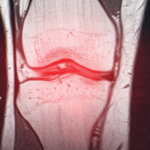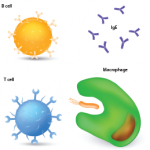Dr. Kuo briefly touched on CITE-sq and REAP-seq, and then turned his attention to scATAC-seq, a technique that can be used to map the chromatin dynamics of single cells. It allows for integrative multi-omic characterization of single cells to reveal molecular dysregulation in pathologic conditions, making it possible to compare a healthy state to a disease state.
Dr. Kuo explained that the fourth technique, mass cytometry, can be used for highly multiplexed single-cell proteomic analysis and is a powerful tool for rheumatic disease research. Likewise, imaging mass cytometry enables highly multiplexed imaging with subcellular resolution. The technique does not require harsh tissue dissociation and thus makes it possible to visualize the spatial relationship between single cells. Even though investigators most frequently analyze 32 parameters during imaging mass cytometry, it is possible to analyze more than 100 parameters.
Dr. Kuo then described EpiTOF, a technique that makes it possible to determine single-cell heterogeneity in histone modifications. This epigenetic variability is indicative of distinct hematopoietic lineage and/or functional state. He presented his unpublished research using EpiTOF to analyze samples from patients with systemic juvenile idiopathic arthritis (sJIA), a group that is at a higher risk of developing macrophage activation syndrome. His team found that the monocytes from patients with sJIA have repressed H3ΔN relative to healthy controls. They then discovered that not only does interleukin 6 (IL-6) blockade reverse H3ΔN repression in these monocytes, but that patients on tocilizumab, the anti-IL-6 receptor monoclonal antibody, show no decrease in H3ΔN in monocytes. Consistent with these findings, they documented that treatment of monocytes from healthy individuals with IL-6 was sufficient to induce H3ΔN repression, suggesting that IL-6 promotes macrophage differentiation in sJIA, in part through an epigenetic mechanism.
Public-Private Partnerships
Although single-cell analyses offer many insights, they, unfortunately, can be complex, requiring a combination of clinical expertise and technological expertise. The research team must come together to collect clinical samples, select the technology, perform computational analysis and interpret the data. Moreover, when planning experiments, the research team must thoroughly think through the variables involved, the sample size, the need for paired tissue samples and the importance of longitudinally collected samples.
In most cases, the requirements for single-cell analyses require public-private partnerships because they are beyond any one university’s research capacity. Perhaps the most well known of these partnerships is the Accelerating Medicines Partnership (AMP), comprising the National Institutes of Health, the biopharmaceutical industry and nonprofits, which was formed to facilitate a better understanding of single-cell contributions to rheumatoid arthritis (RA) and SLE. This effort has already proved successful, and single-cell analyses supported by AMP have revealed new insights into RA and SLE pathophysiology.


